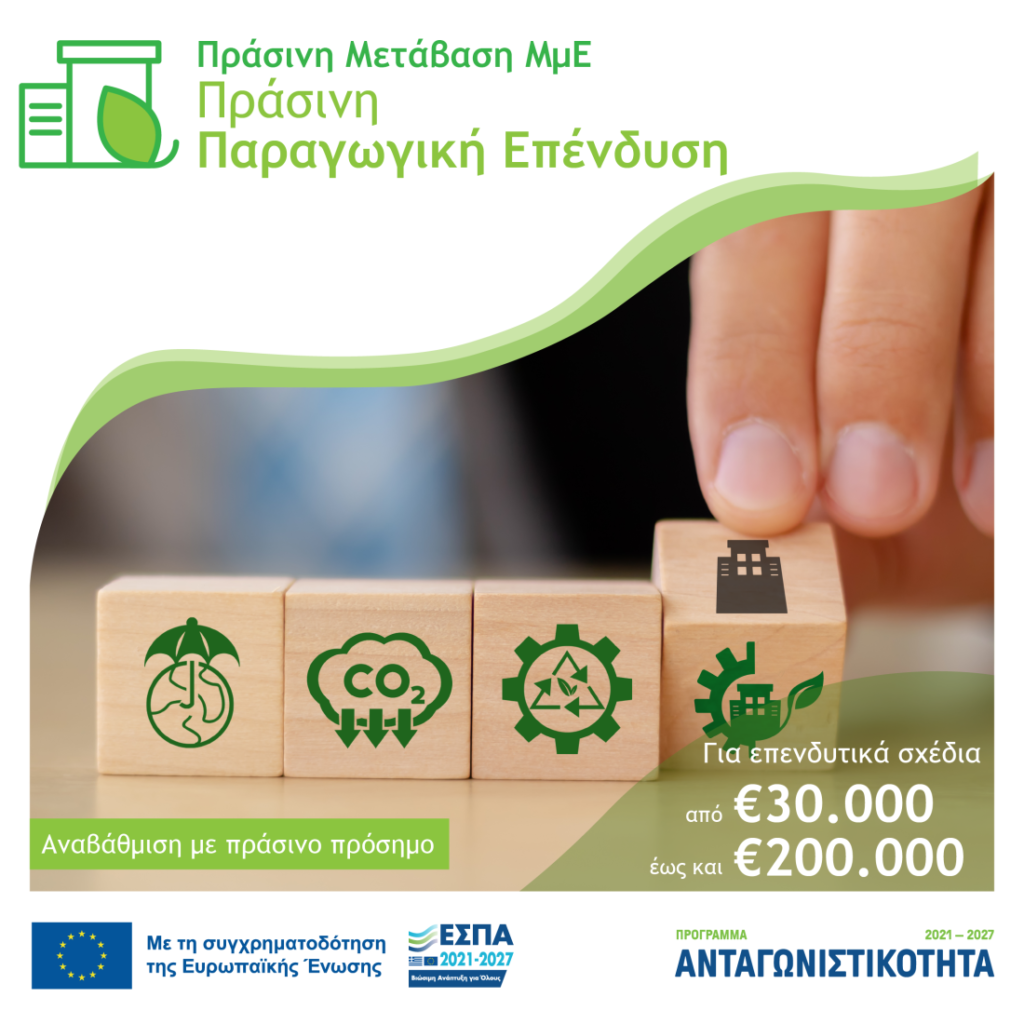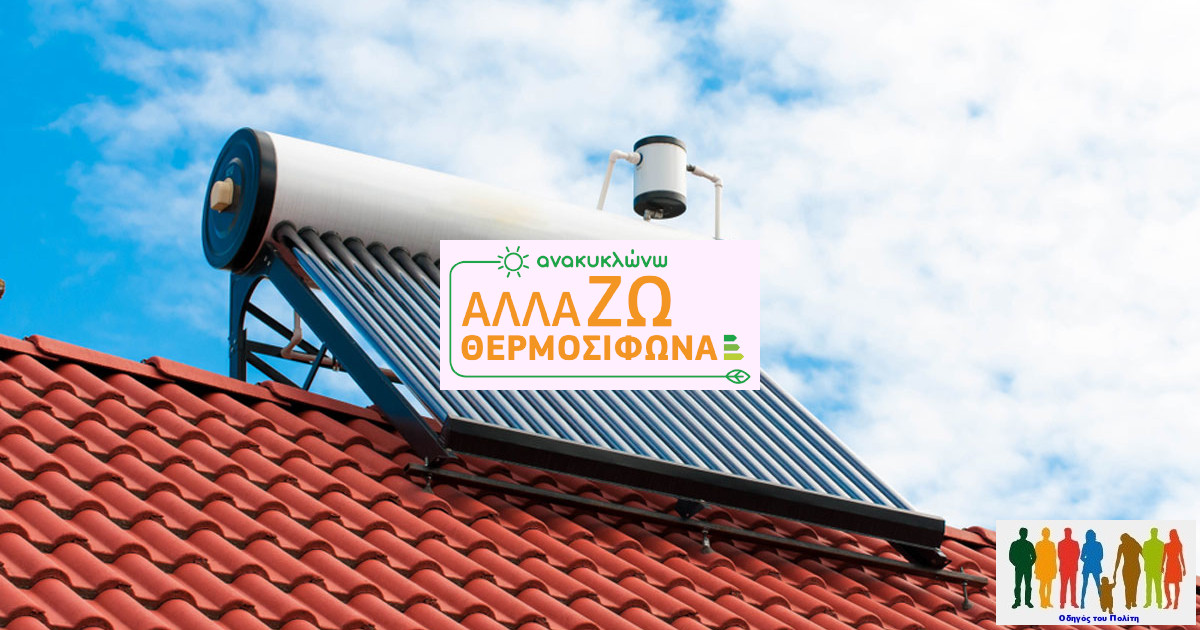
The Green Productive Investment Action for SMEs applies to enterprises that employ at least two (2 ) employees in the calendar year preceding the submission of the funding application.
Grant rate: up to 40%
The grant for the Green Productive Investment SME may receive an additional 10% if it includes Green Transition, GREEN costs at a rate of 20% of the eligible budget of the investment project at the time of the investment project's inclusion. The above increased rate of grant will remain constant during the intermediate verification and payment stage.
The subsidised budget of the investment project can range from 30.000€ to 200.000€.
Green Productive Investment SMEs - TYPICAL REQUIREMENTS
Question 1: In case the Activity Code with the highest revenue is used to fulfil the standard condition ii 'operating in a Main Activity Code or in an Activity Code with the highest revenue' of section 4 of the detailed invitation, which year's data are taken into account?
Answer: For the purposes of meeting standard condition (ii) of section 4 of the detailed call for proposals, the data to be taken into account are those for the full closed financial year relating to the year preceding the submission of the application for funding and for which tax forms have been submitted to
AADE
.
Question 2: Is there a requirement to submit a licensing document when applying for funding?
Answer: The licensing document requirement applies to one of the IDs available to the business, if there is a requirement. In case a company has an IDs for which an authorisation document is required and IDs for which it is not required, it will be required to submit at least one authorisation document.
Question 3: Is a company upon submission required to submit an authorisation document for the investment ID(s)?
Answer: The company is not required to submit a licensing document for the investment ID(s) at the stage of applying for funding.
Question 4: The call states that "A company may submit one (1) new application for funding only if its previous application has been rejected and it has not proceeded to submit an objection or has already voluntarily withdrawn its objection". In case of voluntary withdrawal, will he be entitled to 1 or 2 more submissions if the initial one has not been evaluated?
Answer: According to section 4 "Beneficiaries of the Action - Terms & Conditions & Conditions for Participation' and Chapter 9 'Procedure for submitting the application for funding and the electronic application form', undertakings may submit one (1) more new application for funding in the following cases where: a) there has been a written voluntary withdrawal of their previous application for funding (before the start of the evaluation), b) their initial application has been rejected, c) they have not proceeded to submit an objection, d) they have voluntarily withdrawn their previous objections.
Question 5: Businesses operating in the tourism sector (code 55) must comply with the requirements of paragraph 5.2 at the date of submission of the application for funding. "ELIGIBLE AREAS OF ACTIVITY FOR TOURIST HOTELS" (e.g. a hotel with a 3* star classification is eligible for the action);
Answer: The conditions of paragraph 5.2 of the detailed invitation refer to the minimum restrictions that investment projects with investment code "Accommodation" (code 55) of the Tourism Sector must comply with at the stage of completion and acceptance of the project. For example, a hotel with a 3* (three-star) classification may apply for funding under the action provided that upon completion of the investment project it will be classified in category 4* (four-star) and above with a capacity of twelve (12) beds or more, always in compliance with the other conditions of the action.
Question 6: Do sole proprietorships have an obligation to register in the Register of Beneficial Owners?
Answer: Sole proprietorships are not required to register in the Register of Beneficial Owners as the beneficial owner is considered to be the entrepreneur/owner.
Question 7: For enterprises with a financial year 01/07 - 30/06, which years' financial data are taken into account to determine their size?
Answer: In order to determine the size of the beneficiary enterprise, based on the definition of Commission Recommendation 2003/361/EC, the financial data of the last two (2) closed fiscal years for which the appropriate tax forms have been submitted (e.g. tax forms E3 & N) are attached.
Question 8: On the basis of which year is the calculation of the FTEs used to check the fulfilment of the standard requirement of two (2) FTEs?
Answer: For the fulfilment of the standard requirement of two (2) FTE of dependent work, the data of the calendar year preceding the submission of the application for funding are taken into account. For example, in the case of an enterprise applying for funding in April 2023, the fulfilment of the above condition will be examined on the basis of the data for the PF ERGANI or EFKA-NAT for the period from 1/1/2022 to 31/12/2022.
SUPPORTING DOCUMENTS FOR ADMISSION/CRITERIA TO BE ASSESSED
Question 9: If the company is a member of an organised uniform distribution network of products or services, should the SME's Declaration of Responsibility be signed by a Chartered Accountant?
Answer:The SME Declaration of Responsibility must be signed by a Chartered Accountant. If the SME Declaration is signed only by the Beneficiary, it must be accompanied by a Chartered Accountant's Report on the size of the business.
EXPENSES ELIGIBILITY - Green Productive Investment SMEs
Question 10: What date is taken into account for the eligibility of the expenditure of an enterprise's investment project in the case where its application for funding has initially been rejected and a new application for funding has been submitted?
Reply
: The starting date for the eligibility of expenditure for the investment project is the date of submission of the new application for funding.
Question 11: Is expenditure on the purchase of computers and similar equipment eligible?
Answer: The costs for
ICT equipment
(hardware & software) are eligible only if they are necessary for the operation of the assisted production machinery.
Therefore, during the implementation of the investment project, the ICT equipment should be included in the same invoice or contract as the new assisted production machinery. Alternatively, the supplier of the assisted production machinery should explicitly specify (e.g. in a tender or other official document) the necessity of the ICT equipment for the proper functioning of the assisted production equipment.
Question 12: According to the detailed invitation in Annex I of the Application Documents it is stated that two (2) tenders for each expenditure of categories 1 to 9, with a net value of more than 50.000€, must be submitted during the submission of the funding application. Does this requirement apply at the level of expenditure or category of expenditure?
Answer: This requirement applies to each discrete physical item, at the level of (recording) expenditure in the IPSAS, regardless of the category to which it belongs. It should be noted that the single expenditure for the same physical object should not be split to avoid this obligation. If at least two (2) tenders are not submitted, the expenditure in question shall be rejected.
Only in the event that it is not possible to submit a second tender (e.g. special constructions etc.), one (1) accompanied by relevant documentation shall be submitted.
Question 13: Is expenditure category 11 "Indirect Costs" compulsory? How is it included in the proposed subsidised budget of the investment project?
Answer: This category is mandatory. Indirect costs are calculated on the basis of a fixed rate of 7% of the total direct eligible costs of the operation and are included in the total subsidised budget of the investment project.
For example, for a funding application with a total grant budget of 132.680€:
Total Grant Budget Direct Expenditure 124.000€
Indirect Costs: 124.000€ × 7% = 8.680€.
Therefore 124.000€ + 8.680€ = 132.680€
Question 14: In category 3 "green equipment" and in particular in subcategory 3.3 equipment concerning the installation of photovoltaic plants and storage systems for electricity production and self-production:
a) is the cost of installing net metering eligible?
(b) can the electricity produced be fed into the grid and offset against the electricity consumed, or should the electricity produced be used exclusively to meet the needs of the business?
c) the installed capacity may exceed 10kW and will it be for the subsidy of a single connection contract with the TEN-T;
Answer:
α) Yes, the cost of installing net metering is eligible under category 3.3 and concerns the supply and installation of photovoltaic power plants up to 10kW, storage systems for electricity production and smart meters and telemetry (smart metering).
b) The electricity produced can also be fed into the grid to be offset against the energy consumed (self-generation through energy offsetting).
The management of the storage systems (batteries) aims to maximize the self-consumption of the energy produced by the PV plant. During the operation of the system (PV with battery) the energy produced by the PV station is primarily channelled to the beneficiary's consumption. Any excess production is channelled into the storage system until it is filled and only when this has been done, the available energy of the PV can be injected into the grid. In periods when the energy produced by the PV station is not sufficient to cover the beneficiary's consumption, these are covered primarily by discharging the storage system and secondarily by absorbing energy from the grid.
c) The installed production capacity of the photovoltaic power plant is specified in the Connection Agreement, as it results from the agreed consumption capacity of the company, the energy needs that the company aims to cover, the electromechanical study of the installation in which the photovoltaic power plant to be connected is installed, from the operating license of the company, and/or from a certificate and other appropriate documentation from a competent person/agency. However, the subsidy is given up to a maximum of 10kW of installed PV capacity. In any case, the subsidy will vary according to the connection contracts the company has concluded with the DEDDIE. If there is e.g. a 15kW Connection Contract - then it can be accepted, but it will be subsidized for 10kW and the remaining 5kW will have to be covered by the company's available resources.
Question 14 A: In the subcategory of equipment expenditure 3.3 concerning the installation of photovoltaic plants and storage systems for electricity production and self-production, are the costs for storage systems eligible?
Reply
: With regard to expenditure 3.3 'Equipment for the installation of photovoltaic stations and storage systems for electricity production and to cover own needs', expenditure on storage systems is eligible only when combined with the supply and installation of new photovoltaic stations, involving the storage of energy produced by them, the storage system absorbs at least 75 % of its energy, on an annual basis, from directly connected renewable energy production installations and are elements of a single investment.
PROCESS FOR IMPLEMENTATION - MONITORING OF PROJECTS - Green Productive Investment SMEs
Question 15: Is relocation, during the implementation phase, to another Region allowed?
Answer: During the implementation phase of the investment projects, the beneficiaries must not relocate the aided investment outside the region of establishment.
Question 16: At the completion of the investment project, is there an obligation to maintain the new staff's wage and salary records?
Answer: The requirement to maintain the PPAs does not concern the new personnel subsidised under expenditure category 10 (wage costs of new employees), but the obligation of the enterprise, at the completion of its investment project, to maintain, during the 12 months preceding the submission of the final verification request, the PPAs of salaried employees that it had in the 12 months preceding the submission of the application for financing of the investment project.
In the calculation of the maintenance of the PPAs, the subsidised PPAs of the enterprise for the period of time subsidised by the Action are not taken into account. In the event that the undertaking retains the additional PPAs beyond the period for which they were granted, they are counted in the above calculation.




